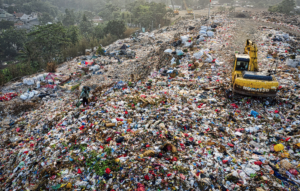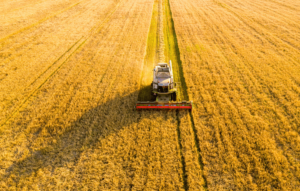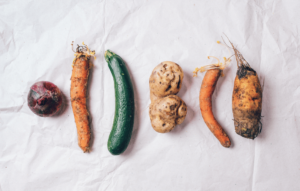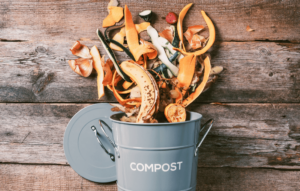Every year, over one-third of all food produced worldwide is wasted – approximately 1.3 billion tons of it. But food waste isn’t just about tossing out leftovers or buying more than you can eat. It’s a massive environmental and social issue hiding in plain sight. When food gets thrown away, so do all the resources that went into growing, transporting, and storing it. This means wasted water, energy, land, and human effort – making food waste one of the most overlooked drivers of climate change and environmental damage.

If we can turn this issue, the impact would be immense – not only for the planet but also for our wallets and communities. In this blog, we’ll break down why food waste matters and how small changes can make a big difference.
The Environmental Impact of Food Waste
When food is discarded, its environmental impact doesn’t vanish – it multiplies. Food that ends up in landfills rots and produces methane, a greenhouse gas up to 25 times more potent than carbon dioxide. This makes food waste a significant contributor to climate change. On a global scale, the amount of methane produced by food waste is enough to put it among the top greenhouse gas emitters, rivaling entire countries. But the problem doesn’t end there.
Growing, processing, and transporting food requires vast amounts of resources like water, energy, and land, all of which essentially go to waste when food goes uneaten. Each year, over 45 trillion gallons of water are wasted globally on food that never reaches our plates. This is enough to fill thousands of Olympic-sized swimming pools and is greater than the annual water usage of many countries. Similarly, the energy expended in harvesting, packaging, shipping, and refrigerating food is all for nothing when that food is thrown out.
Additionally, food production is one of the main drivers of land use change. Forests are cleared, and natural habitats are destroyed to create farmland that grows food – often food that never makes it to our plates. This not only contributes to habitat loss and soil erosion but also disrupts entire ecosystems and accelerates deforestation. Addressing food waste isn’t just about managing scraps; it’s about conserving our most precious resources and protecting the planet from unnecessary environmental destruction.
and soil erosion but also disrupts entire ecosystems and accelerates deforestation. Addressing food waste isn’t just about managing scraps; it’s about conserving our most precious resources and protecting the planet from unnecessary environmental destruction.
By reducing food waste, we can cut down on greenhouse gas emissions, save water and energy, and make better use of the land that is already being farmed – all of which are critical for a sustainable future.
How Does Food Waste Happen?
Food waste occurs at nearly every step of the food system, from farms to households, making it a complex issue that requires action at all levels.
Household Waste
Unfortunately, one of the largest contributors to food waste is right in our home. People often buy more than they need, get distracted by special offers, or lack proper meal planning. In the U.S. alone, the average family throws away around 20-25% of the food they buy, which is like tossing out one out of every four bags of groceries. Improper storage and misunderstanding of food labels also play a role – many people throw away food because they misinterpret “best by” or “sell by” dates as expiration dates when the food may still be perfectly safe to consume.
People often buy more than they need, get distracted by special offers, or lack proper meal planning. In the U.S. alone, the average family throws away around 20-25% of the food they buy, which is like tossing out one out of every four bags of groceries. Improper storage and misunderstanding of food labels also play a role – many people throw away food because they misinterpret “best by” or “sell by” dates as expiration dates when the food may still be perfectly safe to consume.
Aesthetic Preference in Retail and Restaurants
Food waste is also prevalent at the retail level. Supermarkets often reject produce that doesn’t meet aesthetic standards, such as fruits and vegetables that are oddly shaped or slightly blemished, even though they are perfectly good to eat. This practice can lead to tons of food being discarded before it ever reaches consumers. In restaurants, over-preparation of dishes, large portion sizes, and buffet-style offerings all lead to excess food ending up in the trash. The pressure to keep shelves stocked and plates overflowing contributes to a culture of overconsumption, with unsold or uneaten food rarely repurposed or composted.
Agricultural Losses
On the farm, food loss often occurs due to factors like poor harvesting techniques, pest damage, and unpredictable weather. Surplus food that doesn’t meet market demand or quality standards is left in the fields or used as animal feed, even when it’s fit for human consumption. In some cases, overproduction – when farmers grow more food than can be sold at a profit – leads to perfectly edible crops being left to rot.
Addressing food waste requires identifying these different causes and tackling them with specific, targeted solutions. From consumers making better purchasing decisions to supermarkets accepting “imperfect” produce and farms adopting more efficient harvesting practices, change is possible at every level.
Economic and Social Implications
Food waste also harms our environment in more subtle ways; it comes with huge economic and social costs that naturally trickle down into our ecosystems. The financial loss tied to food waste is staggering – up to billions of dollars yearly. At a household level, the average American family of four throws away about $1,500 worth of food annually. This is money that could have gone to other essentials, or even saved. Restaurants, retailers, and food producers also face significant losses due to waste, which often gets passed on to consumers in the form of higher food prices.
Social Injustice
While millions of tons of food are wasted globally, an estimated 828 million people face hunger, with food insecurity affecting even some wealthier nations. The irony is that the food we discard could potentially feed those who need it most. Better management of surplus food and more effective distribution channels could make a significant dent in hunger. However, it’s not just about redistributing waste; it’s about improving efficiency across the entire food system to ensure that valuable resources are not lost.

Wider Economic Consequences
Beyond the direct costs to families and businesses, food waste has broader economic implications. The resources used in food production – land, water, energy, and labor – all carry costs. When food is wasted, the money and resources invested in producing it are also wasted. For example, the agriculture sector accounts for a large chunk of water and energy use, and when the resulting food is thrown away, it represents a misallocation of these incredibly valuable resources.
By reducing food waste, we not only save money but also reduce the strain on natural resources, potentially lowering the overall cost of food production and making food more affordable and accessible for everyone.
Strategies to Reduce Food Waste
Reducing food waste may seem like a big task, but there are practical strategies that can be taken at every level – from households to policy-makers – that can make a significant difference. Here are some ways to address the issue effectively:
Simple Steps for Households to Save Food and Money
- Plan Your Meals and Shop Smart: A bit of planning goes a long way. Plan your meals for the week, make a shopping list, and stick to it. Only buy what you need, and avoid bulk purchases for perishables that might spoil before you can use them.
- Use Proper Storage Techniques: Proper storage can extend the life of your food. For instance, keep fruits and vegetables in appropriate temperature
 conditions, and learn which items should not be stored together (like apples and bananas, which can speed up ripening in other fruits).
conditions, and learn which items should not be stored together (like apples and bananas, which can speed up ripening in other fruits). - Understand Food Labels: “Best by,” “sell by,” and “use by” dates often indicate quality rather than safety. Trust your senses and judgment; just because a food item is past its labeled date doesn’t necessarily mean it’s unsafe to eat. Many foods, like bread or hard cheese, can be consumed past their “best by” dates if they show no signs of spoilage.
Smarter Business for Less Waste
- Donation and Repurposing Programs: Many retailers and restaurants are starting to donate unsold but still fresh food to local shelters, food banks, or community kitchens. Implementing donation programs helps redistribute surplus food to those in need while reducing waste.
- Accepting and Promoting “Ugly” Produce: Grocery stores can lead the way in reducing waste by stocking “ugly” produce that doesn’t meet typical visual standards but is just as nutritious and tasty as its more perfect-looking counterparts. Campaigns that encourage customers to buy these items can help change perceptions and make use of food that would otherwise go to waste.
- Smart Stock Management and Portion Control: For restaurants, preparing food based on demand, offering smaller portion sizes, and finding creative ways to use leftovers can dramatically reduce the volume of food that ends up in the trash. Many restaurants have also started composting food scraps as a sustainable alternative to disposal.
Government and Policy Interventions
- Support for Food Donation and Waste Reduction Initiatives: Governments can play a crucial role by providing incentives for food donation, such as tax breaks or liability protection for businesses. Supporting public education campaigns about food waste and encouraging composting at local and national levels can also help.
- Encouraging Circular Food Systems: Policies promoting circular economies in food systems can ensure that by-products and waste are reused, repurposed, or recycled. This can involve everything from converting food scraps into animal feed or bioenergy to promoting composting programs that nourish the soil instead of sending waste to landfills.
Innovative Technology and Solutions
- Tech-Savvy Food Management: New technologies are emerging to help manage food waste more efficiently. For households, apps that track inventory and offer recipes based on what you already have can help reduce waste. For retailers, systems that better predict demand and manage stock can minimize surplus.
- Creative Solutions for Repurposing Food Waste: Entrepreneurs are finding ways to turn food scraps into new products – like using vegetable peelings to make snacks or converting coffee grounds into fertilizer. These innovations represent exciting opportunities for reducing food waste and making better use of resources.

By adopting these strategies, we can collectively reduce food waste, make better use of our resources, and ensure that food gets to where it’s most needed. Whether you’re an individual, a business, or a policy-maker, there are actions you can take to contribute to a more sustainable food system.
Heading Toward a Future of Less Waste
Reducing food waste is more important than ever – it’s a valuable opportunity that all of us can partake in to protect our planet, support social equity, and save money. Every action, whether it’s planning meals more carefully, encouraging stores to stock “ugly” produce, or implementing policies that support food redistribution, contributes to a larger movement toward sustainability. By valuing food as the precious resource it is, we can significantly reduce our environmental footprint, ease the strain on natural resources, and make strides toward a more equitable food system.
The challenge of food waste may be enormous, but the opportunities for positive change are just as great. By taking small steps, you can be part of a global shift toward more responsible food consumption, creating a future where food is valued, resources are preserved, and hunger is minimized.
Together, we can create a sustainable world – one meal at a time.



 conditions, and learn which items should not be stored together (like apples and bananas, which can speed up ripening in other fruits).
conditions, and learn which items should not be stored together (like apples and bananas, which can speed up ripening in other fruits).






